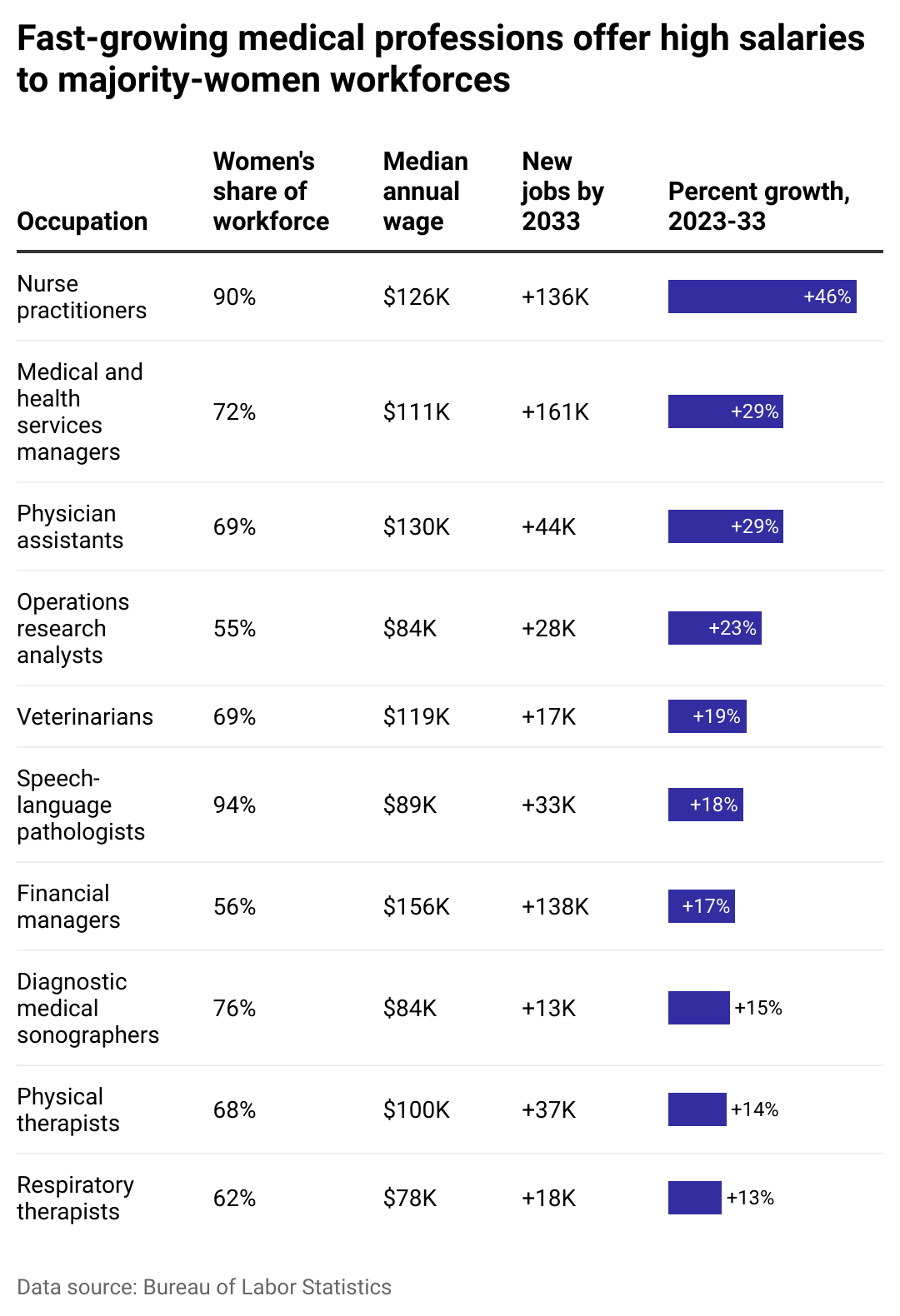These women-dominated, high-paying jobs are growing the fastest this decade

Alliance Images // Shutterstock
These women-dominated, high-paying jobs are growing the fastest this decade
A woman in scrubs holding her hand in the air on a patio facing a city.
After the COVID-19 pandemic triggered an exodus of women from the workforce, largely due to inaccessible child care and a heteronormative culture where women remain the default caretakers, a record number are now participating in the U.S. economy again. Their increased representation compared to before the pandemic is a trend that’s sustained even as the labor market cooled off in recent months.
Over the next decade, demand for a number of women-dominated jobs paying six figures or more is forecast to rise at an above-average pace.
JobTest.org used Bureau of Labor Statistics data to identify the highest-paying, women-dominated jobs projected to grow the fastest over the next decade. The analysis looks at jobs where at least half of employees were women and where typical earnings were 1.5 times the median for all occupations. Those occupations were then ranked by the 10 forecast to grow the fastest.
The modern growth of women in the workforce has been propelled by a trend in women achieving higher rates of college education than men and the shifting makeup of formerly male-dominated fields, according to a Pew Research Center analysis.
Some of the fastest-growing jobs with the highest pay for women through the next decade include those long stereotyped as “women’s roles,” partly because they involve elements of nurturing or caretaking. Nursing and speech-language pathology, which has historically focused on working with children, are among them.
These fields, however, require highly skilled workers and are also projected to benefit the women working in them. The Department of Labor forecasts that they’ll see outsized growth in demand in the coming years, driven by an aging population that will require more nursing care and speech therapy for older generations that develop conditions affecting their motor skills.
That high demand for medical roles and others in fields like finance and business operations may contribute to even higher wage increases, just as it did for nursing during the pandemic’s peak.
![]()

JobTest.org
Even in high-paying, fast-growing fields, wage gaps persist
A table of 10 fast-growing careers, showing women’s share of the workforce, the median annual wage, new jobs to be added by 2033, and the percent growth projected from 2023 to 2033. These are jobs making at least 1.5 times the median income and where at least half of workers are women.
Other fast-growing and high-paying jobs haven’t always been stereotypically associated with a mostly women workforce, and they will see high demand for the foreseeable future as women now make up most workers.
Women in veterinary science, financial management, and operations research analyst positions have been growing as a portion of the workforce thanks to a generation of trailblazing women who embraced STEM careers, which have historically been male-dominated. Financial institutions have been compelled to diversify their workforces in recent years based, in part, on evidence that firms with women leaders see better returns than those led by men.
Still, gender differences in pay remain a reality—even in some of the highest-paying and fastest-growing occupations. Even women with advanced certificates and college degrees earn 71 cents for every dollar a man with the same education earns, according to a recent Census Bureau analysis of college records and earnings from 2005 to 2019.
Despite progress toward equitable representation in mostly nonmanagerial roles, women still lag behind men in representation and pay in the finance industry overall. The same is true for several of the top 10 fastest-growing occupations dominated by women.
Even among nurse practitioners, where women comprise 9 in 10 workers, they still earn about 2% less than men. For women working in medical and health services management roles, the earning gap is 6% less than for men. Women physician assistants—a group projected to grow 29% by 2033—earn 8% less than their male counterparts on average.
However, there is reason to believe that the wage gap could continue to narrow. As more women enter and participate in the workforce, the difference in pay between genders tends to shrink, a trend that’s played out globally in recent decades, according to Goldman Sachs Research.
Story editing by Alizah Salario. Additional editing by Kelly Glass. Copy editing by Paris Close. Photo selection by Lacy Kerrick.
This story originally appeared on jobtest.org and was produced and
distributed in partnership with Stacker Studio.